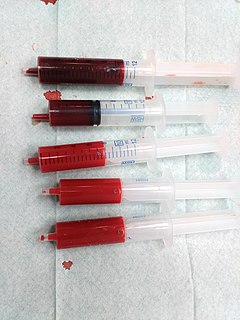
Leukemia, also spelled leukaemia, is a group of blood cancers that usually begin in the bone marrow and result in high numbers of abnormal blood cells. These blood cells are not fully developed and are called blasts or leukemia cells. Symptoms may include bleeding and bruising, feeling tired, fever, and an increased risk of infections. These symptoms occur due to a lack of normal blood cells. Diagnosis is typically made by blood tests or bone marrow biopsy.

Acute lymphoblastic leukemia (ALL) is a cancer of the lymphoid line of blood cells characterized by the development of large numbers of immature lymphocytes. Symptoms may include feeling tired, pale skin color, fever, easy bleeding or bruising, enlarged lymph nodes, or bone pain. As an acute leukemia, ALL progresses rapidly and is typically fatal within weeks or months if left untreated.

The myeloblast is a unipotent stem cell which differentiates into the effectors of the granulocyte series. It is found in the bone marrow. Stimulation of myeloblasts by G-CSF and other cytokines triggers maturation, differentiation, proliferation and cell survival.

Acute myeloid leukemia (AML) is a cancer of the myeloid line of blood cells, characterized by the rapid growth of abnormal cells that build up in the bone marrow and blood and interfere with normal blood cells. Symptoms may include feeling tired, shortness of breath, easy bruising and bleeding, and increased risk of infection. Occasionally, spread may occur to the brain, skin, or gums. As an acute leukemia, AML progresses rapidly and is typically fatal within weeks or months if left untreated.

Acute myeloblastic leukemia with maturation (M2) is a subtype of acute myeloid leukemia (AML).

Cluster of differentiation antigen 135 (CD135) also known as fms like tyrosine kinase 3 (FLT-3), receptor-type tyrosine-protein kinase FLT3, or fetal liver kinase-2 (Flk2) is a protein that in humans is encoded by the FLT3 gene. FLT3 is a cytokine receptor which belongs to the receptor tyrosine kinase class III. CD135 is the receptor for the cytokine Flt3 ligand (FLT3L).

ETV6 protein is a transcription factor that in humans is encoded by the ETV6 gene. The ETV6 protein regulates the development and growth of diverse cell types, particularly those of hematological tissues. However, its gene, ETV6 frequently suffers various mutations that lead to an array of potentially lethal cancers, i.e., ETV6 is a clinically significant proto-oncogene in that it can fuse with other genes to drive the development and/or progression of certain cancers. However, ETV6 is also an anti-oncogene or tumor suppressor gene in that mutations in it that encode for a truncated and therefore inactive protein are also associated with certain types of cancers.

CCAAT/enhancer-binding protein alpha is a protein encoded by the CEBPA gene in humans. CCAAT/enhancer-binding protein alpha is a transcription factor involved in the differentiation of certain blood cells. For details on the CCAAT structural motif in gene enhancers and on CCAAT/Enhancer Binding Proteins see the specific page.
Accelerated phase chronic myelogenous leukemia is a phase of chronic myelogenous leukemia in which the disease is progressing. In this phase, 10 to 19 % of the cells in the blood and bone marrow are blast cells. In the accelerated phase, these leukemia cells grow quickly.

Amonafide is a drug that is being studied in the treatment of cancer. It belongs to a novel family of chemotherapeutic drugs called Naphthalimides and is a potential topoisomerase inhibitor and DNA intercalator.
Blastic phase chronic myelogenous leukemia is a phase of chronic myelogenous leukemia in which more than 30% of the cells in the blood or bone marrow are blast cells. When tiredness, fever, and an enlarged spleen occur during the blastic phase, it is called blast crisis.
Chronic eosinophilic leukemia is a form of cancer in which too many eosinophils are found in the bone marrow, blood, and other tissues. Most cases are associated with fusion genes.
Chronic phase chronic myelogenous leukemia is a phase of chronic myelogenous leukemia in which 5% or fewer of the cells in the blood and bone marrow are blast cells. This phase may last from several months to several years, and there may be no symptoms of leukemia.
Refractory anemia with excess of blasts (RAEB) is a type of myelodysplastic syndrome with a marrow blast percentage of 5% to 19%.
Oblimersen is an antisense oligodeoxyribonucleotide being studied as a possible treatment for several types of cancer, including chronic lymphocytic leukemia, B-cell lymphoma, and breast cancer. It may kill cancer cells by blocking the production of Bcl-2—a protein that makes cancer cells live longer—and by making them more sensitive to chemotherapy.
T-lymphoblastic leukemia/lymphoma, previously labeled precursor T-lymphoblastic leukemia/lymphoma is a form of lymphoid leukemia and lymphoma in which too many T-cell lymphoblasts are found in the blood, bone marrow, and tissues, particularly mediastinal lymph nodes. Labeling as leukemia or lymphoma depends on which feature is more pronounced in a given situation, but has no biological or treatment implication.

Precursor B-cell lymphoblastic leukemia is a form of lymphoid leukemia in which too many B-cell lymphoblasts are found in the blood and bone marrow. It is the most common type of acute lymphoblastic leukemia (ALL). It is sometimes additionally classified as a lymphoma, as designated leukemia/lymphoma.

Acute myeloblastic leukemia is a form of myeloid leukemia affecting myeloblasts.

Minimally differentiated acute myeloblastic leukemia is a subtype of AML. It is classified as M0 by FAB. It represents 2–3% of all cases of AML. Although minimally differentiated AML was recognized earlier, criteria for FAB M0 were developed in 1987. The blasts in these cases cannot be recognized as myeloid based on morphology and cytochemistry, but immunophenotyping demonstrates myeloid antigens.











